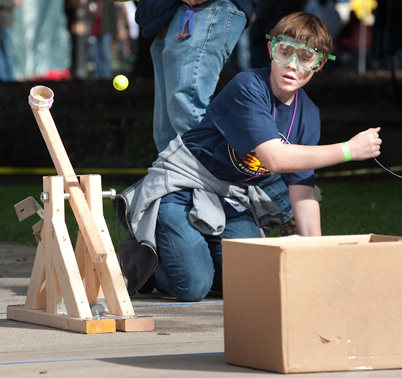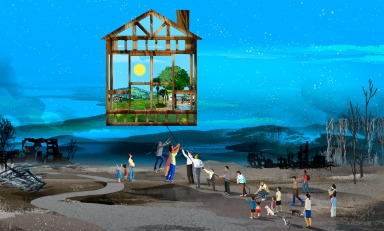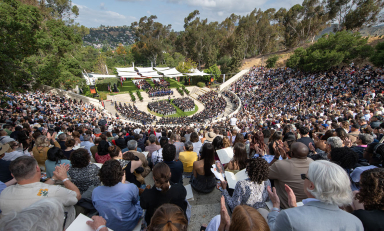
For the fourth straight year, Occidental will host the Los Angeles Regional Science Olympiad, in which grade 4-12 students from about 130 public and private schools will match their wits and wiles for the chance to compete on a national level. This year’s all-day event will take place on Saturday, February 22.
Students prepare for months for the tournament, which has about 60 events in three divisions: elementary, middle and high school. Approximately 2,000 local students grouped into 15-person teams compete in events that require not just knowledge, but critical thinking and problem-solving skills. In particular, the Science Olympiad engages students in science and engineering practices that mirror how scientists and engineers think and work, while stressing collaboration, communication and creativity.
About 150 Occidental and Caltech science and engineering professors and students and other local science educators will judge the competition, now in its 30th year. Events will be held across campus, both in buildings such as Thorne Hall and Booth Hall as well as in the Quad and other outdoor locations. A number of the tournament events are open to public viewing.
Students compete in the divisions of Earth & Space Science, Physical Science & Chemistry, Technology & Engineering and Inquiry & Nature of Science. Subcategories include Anatomy, Disease Detectives, Forestry, Meteorology, Rocks and Minerals, Crime Busters, Food Science, Thermodynamics and Water Quality.
Back this year is the popular Scrambler, in which high school students must build a vehicle powered by a gravitational falling mass with an egg strapped to the front. The Scrambler must get as close to a wall as possible without touching it and thus "scrambling" the egg. The exact distance the Scrambler must travel is not provided in advance.
Middle-school students will face a somewhat similar challenge with RoboCross: They have to build a remote-controlled car that will push different items such as ping pong balls, tennis balls and batteries around to different locations on a course to accumulate points.
The event that always draws the biggest crowd is the egg drop off of the library patio. Elementary-school students must build a device that will cradle an egg so that it will hit a target on the ground but not crack.
Always fun for elementary-age kids is the pasta mobile, in which they must construct a vehicle out of any kind of dried pasta and adhesive and then compete to see how far their vehicles can roll down a curved inclined plane.
Other popular events include the Straw Tower, the Tennis Ball Catapult, Making & Using a Key, the Can Race and Crime Busters.
Several winning middle and high school teams go on to compete at the state finals in April. Winners of the state competition then battle other top teams May 16-17 at the 30th annual Science Olympiad National Tournament at the University of Central Florida in Orlando. Besides a trophy and bragging rights, winners receive grants up to $2,000 for their school.
What began as a grassroots assembly of science teachers is now one of the premiere science competitions in the United States, providing rigorous, standards-based challenges to 7,000 teams in 50 states.



